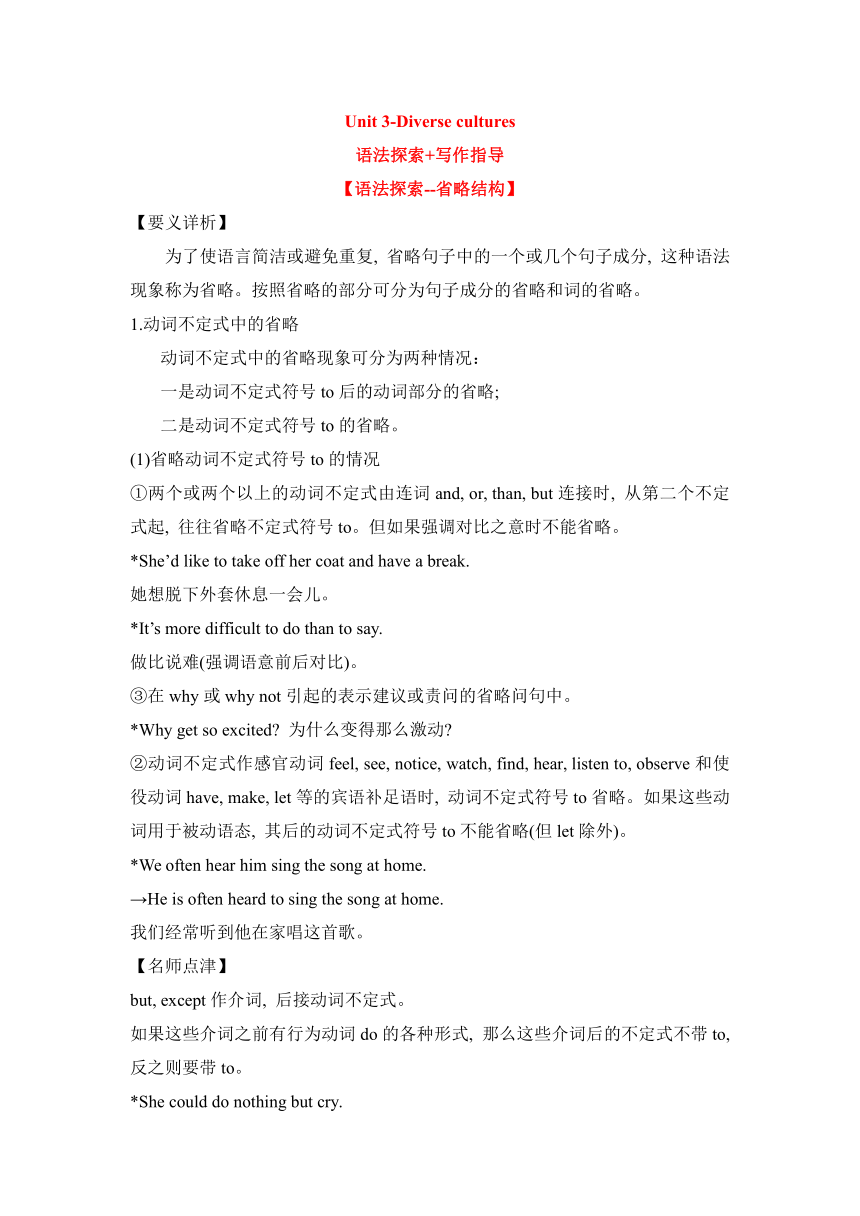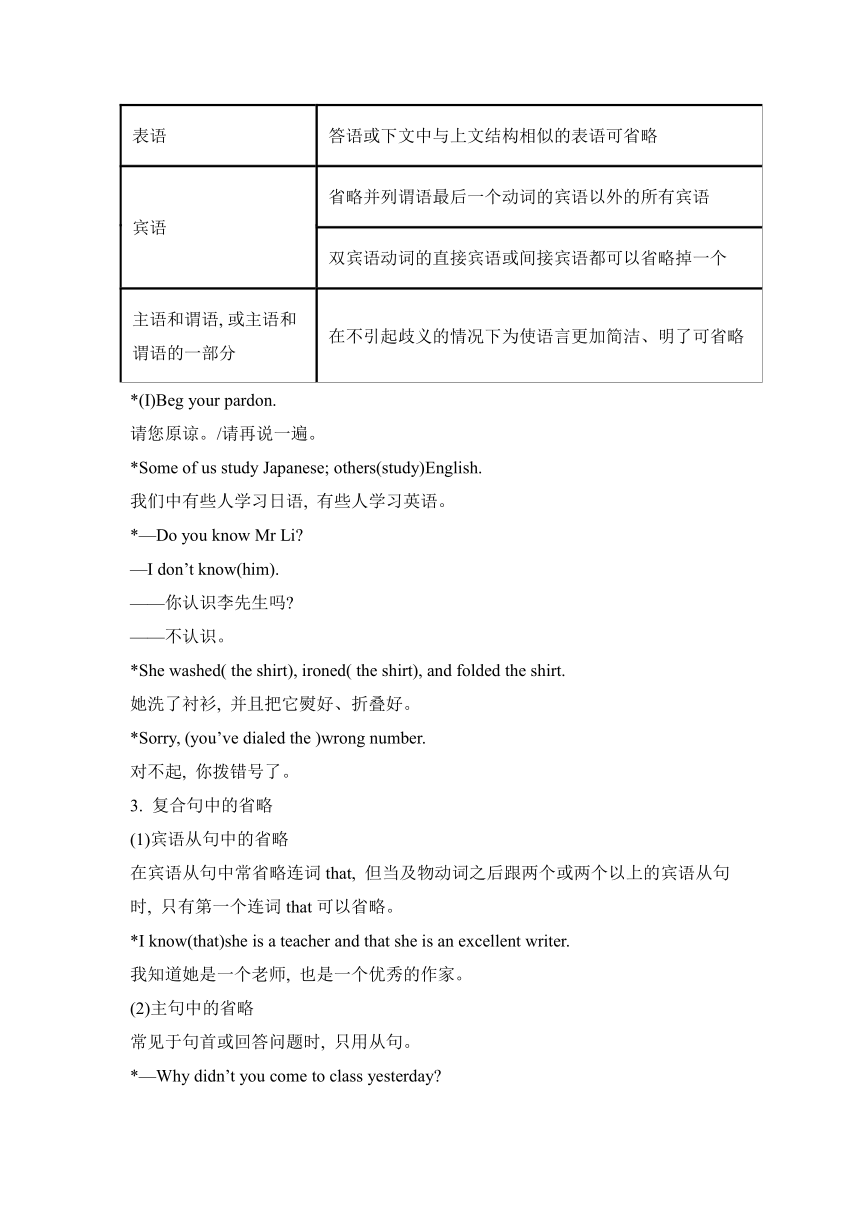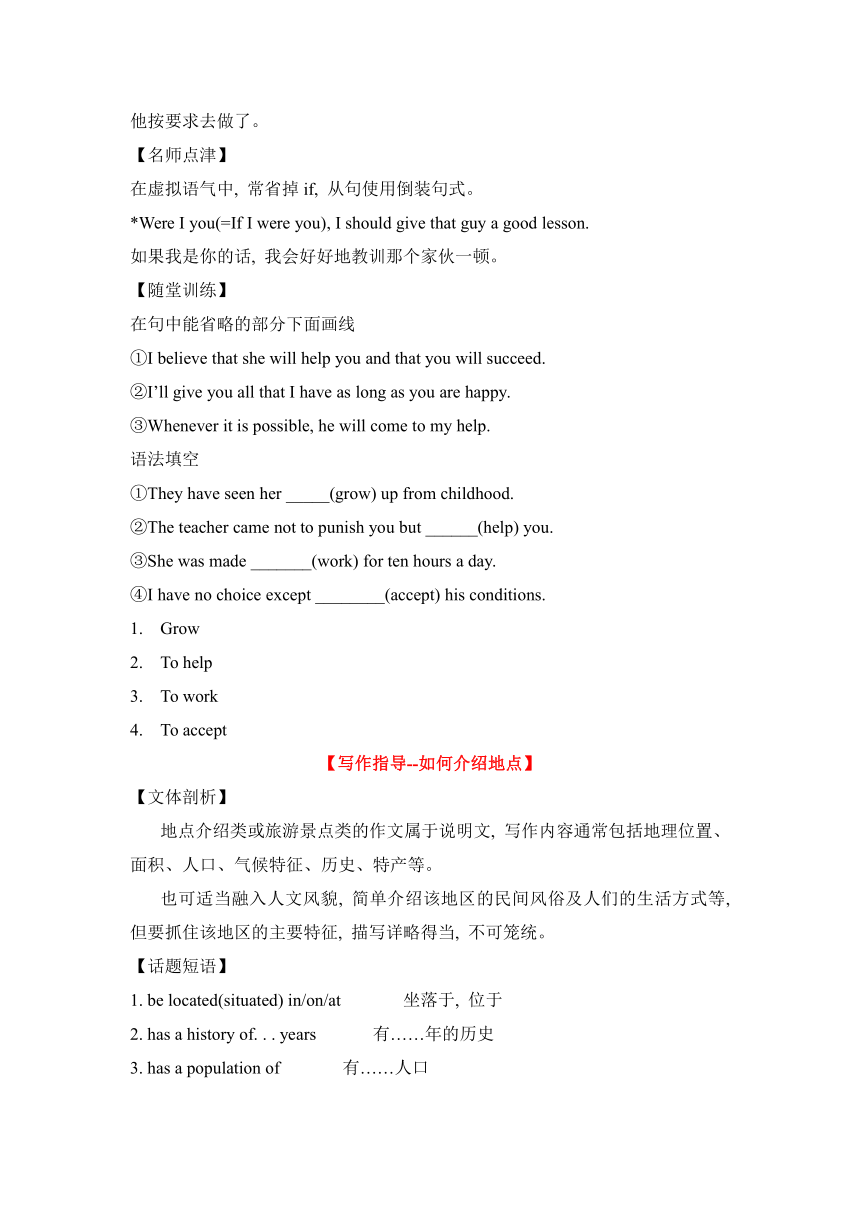人教版(2019)高中英语必修三Unit 3-Diverse cultures语法探索+写作指导
文档属性
| 名称 | 人教版(2019)高中英语必修三Unit 3-Diverse cultures语法探索+写作指导 |  | |
| 格式 | doc | ||
| 文件大小 | 165.0KB | ||
| 资源类型 | 教案 | ||
| 版本资源 | 人教版(2019) | ||
| 科目 | 英语 | ||
| 更新时间 | 2021-06-04 06:20:59 | ||
图片预览





文档简介
Unit 3-Diverse cultures
语法探索+写作指导
【语法探索--省略结构】
【要义详析】
为了使语言简洁或避免重复, 省略句子中的一个或几个句子成分, 这种语法现象称为省略。按照省略的部分可分为句子成分的省略和词的省略。
1.动词不定式中的省略
动词不定式中的省略现象可分为两种情况:
一是动词不定式符号to后的动词部分的省略;
二是动词不定式符号to的省略。
(1)省略动词不定式符号to的情况
①两个或两个以上的动词不定式由连词and, or, than, but连接时, 从第二个不定式起, 往往省略不定式符号to。但如果强调对比之意时不能省略。
*She’d like to take off her coat and have a break.
她想脱下外套休息一会儿。
*It’s more difficult to do than to say.
做比说难(强调语意前后对比)。
③在why或why not引起的表示建议或责问的省略问句中。
*Why get so excited? 为什么变得那么激动?
②动词不定式作感官动词feel, see, notice, watch, find, hear, listen to, observe和使役动词have, make, let等的宾语补足语时, 动词不定式符号to省略。如果这些动词用于被动语态, 其后的动词不定式符号to不能省略(但let除外)。
*We often hear him sing the song at home.
→He is often heard to sing the song at home.
我们经常听到他在家唱这首歌。
【名师点津】
but, except作介词, 后接动词不定式。
如果这些介词之前有行为动词do的各种形式, 那么这些介词后的不定式不带to, 反之则要带to。
*She could do nothing but cry.
她除了哭什么也做不了。
*He has no choice but to leave.
他别无选择只有离开。
(2)省略动词不定式符号to后的动词部分的情况
①一些表示心理活动, 情感态度的动词或短语, 如expect, want, hope, wish, love, hate, decide, plan, mean, try, would like, be ready, be afraid, be glad等后, 动词不定式省略to后面的动词部分, 但保留to。
*—Will you go with me? —Well, I’d like to (go with you).
——你愿意和我一起去吗?
——嗯, 我愿意(和你一起去)。
②不定式作宾语补足语时, 省略to后的动词部分, 即用to代替整个不定式。
*You’d better finish the job on time if he ordered you to( finish the job on time ).
如果他命令你, 你最好按时完成工作。
【名师点津】
如果该不定式后的动词是be或完成时态, 则需在to后加上be或have。
*—Are you a lawyer?
—No, but I hope to be (a lawyer).
——你是律师吗?
*—Have you been to the West Lake?
—I hope to have (been to the West Lake).
——你去过西湖吗?
——我希望去过(西湖)。
—不是, 但是我希望是。
2. 简单句及并列句中的省略
省略成分 情况说明?
主语 在祈使句中和不容易引起歧义的情况下可省略
谓语或谓语的一部分 为了避免与前面已出现过的动词重复常省略
表语 答语或下文中与上文结构相似的表语可省略
宾语 省略并列谓语最后一个动词的宾语以外的所有宾语
双宾语动词的直接宾语或间接宾语都可以省略掉一个
主语和谓语,?或主语和谓语的一部分 在不引起歧义的情况下为使语言更加简洁、明了可省略
*(I)Beg your pardon.
请您原谅。/请再说一遍。
*Some of us study Japanese; others(study)English.
我们中有些人学习日语, 有些人学习英语。
*—Do you know Mr Li?
—I don’t know(him).
——你认识李先生吗?
——不认识。
*She washed( the shirt), ironed( the shirt), and folded the shirt.
她洗了衬衫, 并且把它熨好、折叠好。
*Sorry, (you’ve dialed the )wrong number.
对不起, 你拨错号了。
3. 复合句中的省略
(1)宾语从句中的省略
在宾语从句中常省略连词that, 但当及物动词之后跟两个或两个以上的宾语从句时, 只有第一个连词that可以省略。
*I know(that)she is a teacher and that she is an excellent writer.
我知道她是一个老师, 也是一个优秀的作家。
(2)主句中的省略
常见于句首或回答问题时, 只用从句。
*—Why didn’t you come to class yesterday?
—( I didn’t come to class yesterday )Because I was ill.
——你昨天为什么没来上课?
——因为我病了。
(3)定语从句中的省略
①一般说来, 在限制性定语从句中, 作宾语的关系代词that, which, who, whom可以省略; 而在非限制性定语从句中作宾语的关系代词不可以省略。
*The man (whom)you saw yesterday fell ill.
你昨天见到的那个人生病了。
*The man, whom you saw yesterday, fell ill.
那个人生病了, 你昨天见到他了。
②当先行词是way, 且引导词在定语从句中作方式状语时, 引导词可用in which或that, 也可以省略。
*The way( in which/that )these comrades treat problems is wrong.
这些同志看待问题的方式是错误的。
(4)状语从句中的省略
当状语从句中的主语和主句的主语一致或从句主语是it, 并且从句谓语中有be动词时, 常可以省略从句中的主语和be动词。此类状语从句中的省略有如下情况:
①在as, before, till, until, when, while等引导的时间状语从句中。
*While(I was)walking along the street, I heard my name called.
当我正沿街而行时, 我听到有人叫我的名字。
②在though, although等引导的让步状语从句中。
*Though(they were)tired, they went on working.
虽然累了, 但他们继续工作。
③在if, unless等引导的条件状语从句中。
*You shouldn’t come to his party unless(you are)invited.
除非你被邀请, 否则你不应该来参加他的晚会。
④在as, as if, as though等引导的方式状语从句中。
*He did as(he was)told.
他按要求去做了。
【名师点津】
在虚拟语气中, 常省掉if, 从句使用倒装句式。
*Were I you(=If I were you), I should give that guy a good lesson.
如果我是你的话, 我会好好地教训那个家伙一顿。
【随堂训练】
在句中能省略的部分下面画线
①I believe that she will help you and that you will succeed.
②I’ll give you all that I have as long as you are happy.
③Whenever it is possible, he will come to my help. ?
语法填空
①They have seen her _____(grow) up from childhood.
②The teacher came not to punish you but ______(help) you. ?
③She was made _______(work) for ten hours a day. ?
④I have no choice except ________(accept) his conditions. ?
Grow
To help
To work
To accept
【写作指导--如何介绍地点】
【文体剖析】
地点介绍类或旅游景点类的作文属于说明文, 写作内容通常包括地理位置、面积、人口、气候特征、历史、特产等。
也可适当融入人文风貌, 简单介绍该地区的民间风俗及人们的生活方式等, 但要抓住该地区的主要特征, 描写详略得当, 不可笼统。
【话题短语】
1. be located(situated) in/on/at 坐落于, 位于
2. has a history of. . . years 有……年的历史
3. has a population of 有……人口
4. be home to 是……的家园
5. be known/famous as 作为……而出名
6. cover an area of . . . 占地……(面积)
7. the reform and opening-up policy 改革开放政策
8. great changes have taken place 发生巨大变化
9. take on a new look 呈现新面貌
10. make contributions to 为……做出贡献
11. diverse cultures多元文化
12. talk about Chinese ethnic minority cultures谈谈中国的少数民族文化
13. the origins of the American food美国食物的起源
14. be invented in在……被发明/创造
15. so many beautiful old buildings如此多漂亮的古建筑
16. be influenced by受……的影响
17. historical changes 历史变迁
18. have a history of 有……的历史
19. cultural conflict文化冲突
20. cross-cultural communication跨文化交流
【话题句式】
1. The countries of Asia are diverse in their cultures and traditions.
亚洲国家有多样的文化和传统。
2. The origins of gunpowder in China also date from the 9th century AD.
火药在中国也是起源于公元9世纪。
3. Bicycles were invented in France in the 1790s.
自行车于18世纪90年代在法国发明。
4. Most people eat turkey and pumpkin pie and other special dishes.
大多数人吃火鸡、南瓜馅饼和其他特制的菜。
5. It is likely that an Italian with a working facility in English would have been hired, but my friend did not look like an Italian.
如果一个意大利人带着教英文的设备就有可能被雇用, 可是我的朋友看起来不像是一个意大利人。
6. Most people living here were employed in the mines, and other industries were neglected.
许多生活在这里的人都去采矿了, 而忽视了其他行业。
7. Today, more and more foreigners learn Mandarin, which is a good sign that China plays the important role in the world.
今天, 越来越多的外国人学习普通话, 这是中国在世界上发挥重要作用的表现。
8. With increased interaction between the world’s nations, there is a great urgency for us to absorb different cultures.
随着世界各国间交流的增多, 我们迫切需要学习不同的文化知识。
1. 表达位置、人口
(1)China lies in the east of Asia and on the western coast of the Pacific Ocean.
中国位于亚洲东部, 太平洋的西岸。
(2)The beautiful town is located along the shore of the lake.
这个美丽的城镇坐落于湖的沿岸。
(3)The village lies among the mountains.
这个村子坐落在群山之中。
(4)New York is a big city with a population of over 10 million.
纽约是一个有一千多万人口的大城市。
2. 表述特色
(1)Hangzhou is famous/well-known for its beautiful West Lake.
杭州因它美丽的西湖而著名。
(2)Hainan Province consists of Hainan Island and neighbouring isles as well as wide sea areas.
海南省由海南岛和附近的群岛及广阔的海域组成。
(3) Built in the 16th century, the castle has witnessed too much coming and going in history.
建于16世纪, 这座城堡见证了太多的历史浮沉。
(4)There is one place you can’t miss while visiting Kaifeng — the Kaifeng House.
参观开封时, 有一个地方你不能错过——开封府。
3. 表达变化
(1)Great changes have taken place over the past five years in my hometown.
我的家乡在过去的五年中发生了巨大的变化。
(2)Thanks to the reform and opening-up policy, China has taken on a new look.
得益于改革开放政策, 中国的面貌已焕然一新。
【典题演练】
假如你是李华, 请你给某英文报社的“城市风采”栏目写一篇短文, 介绍我们的首都——北京。
要点如下:
1. 基本概况: 人口约2 000万, 面积16 000多平方千米, 位于华北平原北部;
2. 气候: 四季分明, 夏季炎热多雨, 冬季寒冷干燥;
3. 历史与文化: 有3 000多年的历史, 是我国的政治、文化中心, 有很多著名大学, 如清华大学、北京大学等;
4. 交通与旅游: 交通便利, 有天安门广场、故宫、长城等很多旅游景点。
注意:
词数80左右, 可适当增加细节, 以使行文连贯。
【谋篇】
【遣词】
1. _________________占地……(面积)?
2. _________________有……人口?
3. _________________位于?
4. ________________有三千多年的历史
5. __________________四季分明?
6. __________________政治、文化中心?
7. __________________吸引……的注意力?
8. __________________便利的
cover an area of. . .
have a population of. . .
have a population of. . .
have a history of more than 3, 000 years?
four distinct seasons
the political and cultural center
draw the attention of
Convenient
【造句】
1. 完成句子
(1)北京是中国的首都。
(2)北京人口约2 000万, 面积16 000多平方千米。
(3)北京位于华北平原北部。
(4)北京四季分明, 夏季炎热多雨, 冬季寒冷干燥。
(5)北京有3 000多年的历史。
(6)北京是中国的政治、文化中心。
(7)它成功举办了2008年奥运会, 吸引了世界的眼光。
(8)北京有很多著名大学, 清华大学、北京大学是其中最著名的两所。
(9)北京也是一个度假的好去处, 且交通便利。
(10)北京有很多旅游景点, 如天安门、故宫、长城和鸟巢等。
2. 句式升级
(11)把句(1)、(2)合并成含同位语的句子
将句(3)、(4)合并成用分词短语作状语的句子
(13)将句(6)、(7)合并为一句话
Beijing is the capital of China.
Beijing has a population of about 20 million and covers Beijing has a population of about 20 million and covers.
Beijing is located in the north of the North China Plain.
Beijing has four distinct seasons. It is hot and rainy in summer and cold and dry in winter.
Beijing has a history of more than 3, 000 years. ?
Beijing is the political and cultural center of China. ?
It successfully hosted the 2008 Olympic Games and drew the attention of the world.
Beijing has many famous universities; Peking University and Tsinghua University are two of the most famous universities. ?
Beijing is also a great place to enjoy your holiday and it’s convenient to travel there.
There are many places of interest, such as Tian’anmen Square, the Forbidden City, the Great Wall and the Bird’s Nest. ?
Beijing, the capital of China, has a population of about 20 million and covers an area of more than about 20 million 16, 000 square kilometers.
Located in the north of the North China Plain, Beijing has four distinct seasons. It is hot and rainy in summer and cold and dry in winter.
As the political and cultural center of China, Beijing successfully hosted the 2008 Olympic Games and drew the attention of the world.
【成篇】
语法探索+写作指导
【语法探索--省略结构】
【要义详析】
为了使语言简洁或避免重复, 省略句子中的一个或几个句子成分, 这种语法现象称为省略。按照省略的部分可分为句子成分的省略和词的省略。
1.动词不定式中的省略
动词不定式中的省略现象可分为两种情况:
一是动词不定式符号to后的动词部分的省略;
二是动词不定式符号to的省略。
(1)省略动词不定式符号to的情况
①两个或两个以上的动词不定式由连词and, or, than, but连接时, 从第二个不定式起, 往往省略不定式符号to。但如果强调对比之意时不能省略。
*She’d like to take off her coat and have a break.
她想脱下外套休息一会儿。
*It’s more difficult to do than to say.
做比说难(强调语意前后对比)。
③在why或why not引起的表示建议或责问的省略问句中。
*Why get so excited? 为什么变得那么激动?
②动词不定式作感官动词feel, see, notice, watch, find, hear, listen to, observe和使役动词have, make, let等的宾语补足语时, 动词不定式符号to省略。如果这些动词用于被动语态, 其后的动词不定式符号to不能省略(但let除外)。
*We often hear him sing the song at home.
→He is often heard to sing the song at home.
我们经常听到他在家唱这首歌。
【名师点津】
but, except作介词, 后接动词不定式。
如果这些介词之前有行为动词do的各种形式, 那么这些介词后的不定式不带to, 反之则要带to。
*She could do nothing but cry.
她除了哭什么也做不了。
*He has no choice but to leave.
他别无选择只有离开。
(2)省略动词不定式符号to后的动词部分的情况
①一些表示心理活动, 情感态度的动词或短语, 如expect, want, hope, wish, love, hate, decide, plan, mean, try, would like, be ready, be afraid, be glad等后, 动词不定式省略to后面的动词部分, 但保留to。
*—Will you go with me? —Well, I’d like to (go with you).
——你愿意和我一起去吗?
——嗯, 我愿意(和你一起去)。
②不定式作宾语补足语时, 省略to后的动词部分, 即用to代替整个不定式。
*You’d better finish the job on time if he ordered you to( finish the job on time ).
如果他命令你, 你最好按时完成工作。
【名师点津】
如果该不定式后的动词是be或完成时态, 则需在to后加上be或have。
*—Are you a lawyer?
—No, but I hope to be (a lawyer).
——你是律师吗?
*—Have you been to the West Lake?
—I hope to have (been to the West Lake).
——你去过西湖吗?
——我希望去过(西湖)。
—不是, 但是我希望是。
2. 简单句及并列句中的省略
省略成分 情况说明?
主语 在祈使句中和不容易引起歧义的情况下可省略
谓语或谓语的一部分 为了避免与前面已出现过的动词重复常省略
表语 答语或下文中与上文结构相似的表语可省略
宾语 省略并列谓语最后一个动词的宾语以外的所有宾语
双宾语动词的直接宾语或间接宾语都可以省略掉一个
主语和谓语,?或主语和谓语的一部分 在不引起歧义的情况下为使语言更加简洁、明了可省略
*(I)Beg your pardon.
请您原谅。/请再说一遍。
*Some of us study Japanese; others(study)English.
我们中有些人学习日语, 有些人学习英语。
*—Do you know Mr Li?
—I don’t know(him).
——你认识李先生吗?
——不认识。
*She washed( the shirt), ironed( the shirt), and folded the shirt.
她洗了衬衫, 并且把它熨好、折叠好。
*Sorry, (you’ve dialed the )wrong number.
对不起, 你拨错号了。
3. 复合句中的省略
(1)宾语从句中的省略
在宾语从句中常省略连词that, 但当及物动词之后跟两个或两个以上的宾语从句时, 只有第一个连词that可以省略。
*I know(that)she is a teacher and that she is an excellent writer.
我知道她是一个老师, 也是一个优秀的作家。
(2)主句中的省略
常见于句首或回答问题时, 只用从句。
*—Why didn’t you come to class yesterday?
—( I didn’t come to class yesterday )Because I was ill.
——你昨天为什么没来上课?
——因为我病了。
(3)定语从句中的省略
①一般说来, 在限制性定语从句中, 作宾语的关系代词that, which, who, whom可以省略; 而在非限制性定语从句中作宾语的关系代词不可以省略。
*The man (whom)you saw yesterday fell ill.
你昨天见到的那个人生病了。
*The man, whom you saw yesterday, fell ill.
那个人生病了, 你昨天见到他了。
②当先行词是way, 且引导词在定语从句中作方式状语时, 引导词可用in which或that, 也可以省略。
*The way( in which/that )these comrades treat problems is wrong.
这些同志看待问题的方式是错误的。
(4)状语从句中的省略
当状语从句中的主语和主句的主语一致或从句主语是it, 并且从句谓语中有be动词时, 常可以省略从句中的主语和be动词。此类状语从句中的省略有如下情况:
①在as, before, till, until, when, while等引导的时间状语从句中。
*While(I was)walking along the street, I heard my name called.
当我正沿街而行时, 我听到有人叫我的名字。
②在though, although等引导的让步状语从句中。
*Though(they were)tired, they went on working.
虽然累了, 但他们继续工作。
③在if, unless等引导的条件状语从句中。
*You shouldn’t come to his party unless(you are)invited.
除非你被邀请, 否则你不应该来参加他的晚会。
④在as, as if, as though等引导的方式状语从句中。
*He did as(he was)told.
他按要求去做了。
【名师点津】
在虚拟语气中, 常省掉if, 从句使用倒装句式。
*Were I you(=If I were you), I should give that guy a good lesson.
如果我是你的话, 我会好好地教训那个家伙一顿。
【随堂训练】
在句中能省略的部分下面画线
①I believe that she will help you and that you will succeed.
②I’ll give you all that I have as long as you are happy.
③Whenever it is possible, he will come to my help. ?
语法填空
①They have seen her _____(grow) up from childhood.
②The teacher came not to punish you but ______(help) you. ?
③She was made _______(work) for ten hours a day. ?
④I have no choice except ________(accept) his conditions. ?
Grow
To help
To work
To accept
【写作指导--如何介绍地点】
【文体剖析】
地点介绍类或旅游景点类的作文属于说明文, 写作内容通常包括地理位置、面积、人口、气候特征、历史、特产等。
也可适当融入人文风貌, 简单介绍该地区的民间风俗及人们的生活方式等, 但要抓住该地区的主要特征, 描写详略得当, 不可笼统。
【话题短语】
1. be located(situated) in/on/at 坐落于, 位于
2. has a history of. . . years 有……年的历史
3. has a population of 有……人口
4. be home to 是……的家园
5. be known/famous as 作为……而出名
6. cover an area of . . . 占地……(面积)
7. the reform and opening-up policy 改革开放政策
8. great changes have taken place 发生巨大变化
9. take on a new look 呈现新面貌
10. make contributions to 为……做出贡献
11. diverse cultures多元文化
12. talk about Chinese ethnic minority cultures谈谈中国的少数民族文化
13. the origins of the American food美国食物的起源
14. be invented in在……被发明/创造
15. so many beautiful old buildings如此多漂亮的古建筑
16. be influenced by受……的影响
17. historical changes 历史变迁
18. have a history of 有……的历史
19. cultural conflict文化冲突
20. cross-cultural communication跨文化交流
【话题句式】
1. The countries of Asia are diverse in their cultures and traditions.
亚洲国家有多样的文化和传统。
2. The origins of gunpowder in China also date from the 9th century AD.
火药在中国也是起源于公元9世纪。
3. Bicycles were invented in France in the 1790s.
自行车于18世纪90年代在法国发明。
4. Most people eat turkey and pumpkin pie and other special dishes.
大多数人吃火鸡、南瓜馅饼和其他特制的菜。
5. It is likely that an Italian with a working facility in English would have been hired, but my friend did not look like an Italian.
如果一个意大利人带着教英文的设备就有可能被雇用, 可是我的朋友看起来不像是一个意大利人。
6. Most people living here were employed in the mines, and other industries were neglected.
许多生活在这里的人都去采矿了, 而忽视了其他行业。
7. Today, more and more foreigners learn Mandarin, which is a good sign that China plays the important role in the world.
今天, 越来越多的外国人学习普通话, 这是中国在世界上发挥重要作用的表现。
8. With increased interaction between the world’s nations, there is a great urgency for us to absorb different cultures.
随着世界各国间交流的增多, 我们迫切需要学习不同的文化知识。
1. 表达位置、人口
(1)China lies in the east of Asia and on the western coast of the Pacific Ocean.
中国位于亚洲东部, 太平洋的西岸。
(2)The beautiful town is located along the shore of the lake.
这个美丽的城镇坐落于湖的沿岸。
(3)The village lies among the mountains.
这个村子坐落在群山之中。
(4)New York is a big city with a population of over 10 million.
纽约是一个有一千多万人口的大城市。
2. 表述特色
(1)Hangzhou is famous/well-known for its beautiful West Lake.
杭州因它美丽的西湖而著名。
(2)Hainan Province consists of Hainan Island and neighbouring isles as well as wide sea areas.
海南省由海南岛和附近的群岛及广阔的海域组成。
(3) Built in the 16th century, the castle has witnessed too much coming and going in history.
建于16世纪, 这座城堡见证了太多的历史浮沉。
(4)There is one place you can’t miss while visiting Kaifeng — the Kaifeng House.
参观开封时, 有一个地方你不能错过——开封府。
3. 表达变化
(1)Great changes have taken place over the past five years in my hometown.
我的家乡在过去的五年中发生了巨大的变化。
(2)Thanks to the reform and opening-up policy, China has taken on a new look.
得益于改革开放政策, 中国的面貌已焕然一新。
【典题演练】
假如你是李华, 请你给某英文报社的“城市风采”栏目写一篇短文, 介绍我们的首都——北京。
要点如下:
1. 基本概况: 人口约2 000万, 面积16 000多平方千米, 位于华北平原北部;
2. 气候: 四季分明, 夏季炎热多雨, 冬季寒冷干燥;
3. 历史与文化: 有3 000多年的历史, 是我国的政治、文化中心, 有很多著名大学, 如清华大学、北京大学等;
4. 交通与旅游: 交通便利, 有天安门广场、故宫、长城等很多旅游景点。
注意:
词数80左右, 可适当增加细节, 以使行文连贯。
【谋篇】
【遣词】
1. _________________占地……(面积)?
2. _________________有……人口?
3. _________________位于?
4. ________________有三千多年的历史
5. __________________四季分明?
6. __________________政治、文化中心?
7. __________________吸引……的注意力?
8. __________________便利的
cover an area of. . .
have a population of. . .
have a population of. . .
have a history of more than 3, 000 years?
four distinct seasons
the political and cultural center
draw the attention of
Convenient
【造句】
1. 完成句子
(1)北京是中国的首都。
(2)北京人口约2 000万, 面积16 000多平方千米。
(3)北京位于华北平原北部。
(4)北京四季分明, 夏季炎热多雨, 冬季寒冷干燥。
(5)北京有3 000多年的历史。
(6)北京是中国的政治、文化中心。
(7)它成功举办了2008年奥运会, 吸引了世界的眼光。
(8)北京有很多著名大学, 清华大学、北京大学是其中最著名的两所。
(9)北京也是一个度假的好去处, 且交通便利。
(10)北京有很多旅游景点, 如天安门、故宫、长城和鸟巢等。
2. 句式升级
(11)把句(1)、(2)合并成含同位语的句子
将句(3)、(4)合并成用分词短语作状语的句子
(13)将句(6)、(7)合并为一句话
Beijing is the capital of China.
Beijing has a population of about 20 million and covers Beijing has a population of about 20 million and covers.
Beijing is located in the north of the North China Plain.
Beijing has four distinct seasons. It is hot and rainy in summer and cold and dry in winter.
Beijing has a history of more than 3, 000 years. ?
Beijing is the political and cultural center of China. ?
It successfully hosted the 2008 Olympic Games and drew the attention of the world.
Beijing has many famous universities; Peking University and Tsinghua University are two of the most famous universities. ?
Beijing is also a great place to enjoy your holiday and it’s convenient to travel there.
There are many places of interest, such as Tian’anmen Square, the Forbidden City, the Great Wall and the Bird’s Nest. ?
Beijing, the capital of China, has a population of about 20 million and covers an area of more than about 20 million 16, 000 square kilometers.
Located in the north of the North China Plain, Beijing has four distinct seasons. It is hot and rainy in summer and cold and dry in winter.
As the political and cultural center of China, Beijing successfully hosted the 2008 Olympic Games and drew the attention of the world.
【成篇】
